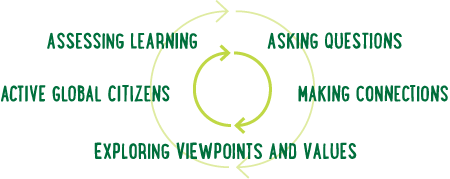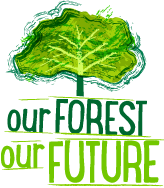How to use this resource...
Our Forest, Our Future helps teachers and pupils to explore the interdependence of people and forests and the vital role forests play in sustaining our environment – in the past, the present and hopefully the future.
The Scots Pine forests in Scotland and the Congo Basin rainforest in Africa provide case studies through which pupils will begin to understand why our forests are under threat and the implications for our planet. Further information about these forests is provided in the following documents.
In making connections between consumerism, people and the environment, pupils will be encouraged to see how they and their actions have an impact on the lives of others globally. It encourages reflection on the possible futures of the world's forests and ways of taking positive actions for a future where people and forests co-exist in a sustainable way.
The resource is structured around a global citizenship framework devised by Oxfam.
More detail on the framework can be found in Global Learning Framework [pdf]
The reflection and evaluation sections in each activity support formative assessment and ongoing monitoring of pupils learning.
Additional assessment opportunities are indicated by... 
Outdoor learning opportunities are indicated by... 
Homework activities are indicated by... 

Taking Action for Change
Education for Global Citizenship is committed to enabling pupils to bring about positive actions for change either locally or globally. This process should support pupils to make their own informed choices through a critical evaluation of the options open to them and the possible implications of those choices.
Throughout the resource there are ideas for possible actions, such as reflecting on our power as consumers, peer education and tree planting. Your pupils themselves should be encouraged to think creatively about the many actions they could take, critically evaluate the impact these actions might have and then evaluate what they have done.
The materials below support your pupils through this process.
> Asking questions
2. What is 'Sustainable Development'?
Aims
To explore the meaning of sustainable development
To understand that not all development is sustainable
To understand how our actions may impact on future developments
To provide a context in which pupils can explore the histories of the forest in Scotland and the Congo Basin rainforest
What to do
Ask pupils to reflect on the meaning of 'development'. Elicit that 'development' means making life better for people. Write the following words up on the board. Clean water, smart shoes, mobile phone, clean air, education, shelter, laptop / computer, fuel, food, trees. In groups, pupils should select their top 5 items which they think are the most important for people's development.
Ask each group to feedback and explain why they think some of the items on the list are more important than others. Now ask the groups to consider if they think all people in Scotland have the same needs? For example an unemployed person or a homeless person. Next ask them to think about people in the Congo Basin rainforest – would their needs be the same too?
Write the word 'sustainable' on the board. Brainstorm with the class what they think the word means and write up their thoughts on the board. A definition might be 'it refers to an activity or process which can be sustained over a long period of time.'
Give the class the following statement. "Sustainable development is development that meets the needs of the present without limiting the ability of future generations to meet their own needs". You can simplify the statement by explaining that we (the pupils / global community) need to leave 'enough' for future generations, and it needs to be 'as good' as they / we had it).
What are their initial thoughts about the statement? Give each group one of the cartoon strips. Explain that we are going to see how some development is sustainable and some isn't. Ask them to read their cartoon. Discuss the following questions and report back to the class.
- Who was responsible for the development?
- Who was affected by the developments?
- Did the developments make life better or worse for people now and in the future? How?
- Is this an example of sustainable development? Why?
Review the original quote and ask them what they think about the statement now.
Hold a plenary discussion using the prompts below.
Reflection and evaluation
What message was the Guardian of the Wood story providing about sustainable development?
What is the difference between sustainable and renewable?
Trees are renewable and forests and woodlands can be regenerated. Therefore we can use wood from sustainably managed forests which support this process.
Teacher notes
Sustainable development is defined as 'development that meets the needs of the present without limiting the ability of future generations' (UN World Commission on Environment and Development)
Trees are a part of a wider ecosystem that helps stabilise the climate and provide the right conditions for human life. The careful and sustainable management of tree planting, protection and felling can help ensure that future generations inherit an earth that will continue to provide fundamental resources. True sustainable development involves a balance between using the Earth for the benefit of the human race and respecting the environment. Sustainable solutions set out to achieve this by:
Continuing to meet the basic needs for human life, society and communities – that is food, water, shelter, transport, communication, etc.
Inflicting no lasting harm on the environment, its ecosystems, animals, water, air, etc.
Cartoons reproduced with kind permissions from Team Planet www.developmenteducation.ie
![]() Teacher info
Scots Pine forest [pdf]
Teacher info
Scots Pine forest [pdf] ![]() Teacher info
Congo Basin rainforest [pdf]
Teacher info
Congo Basin rainforest [pdf]
![]()
![]()
![]()



